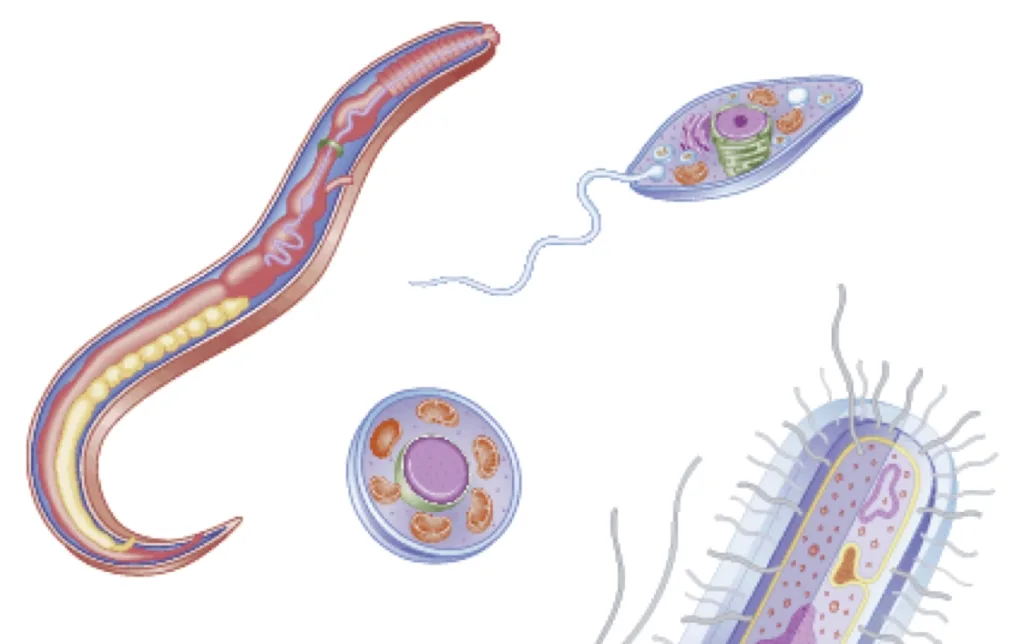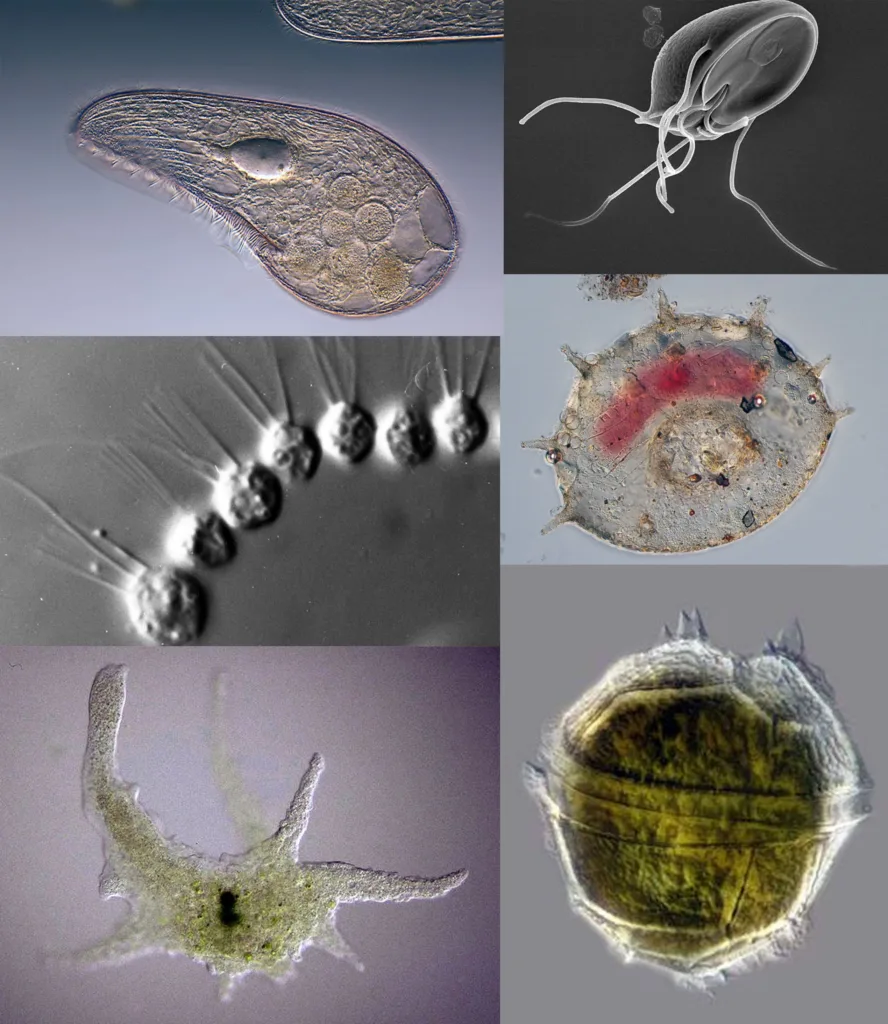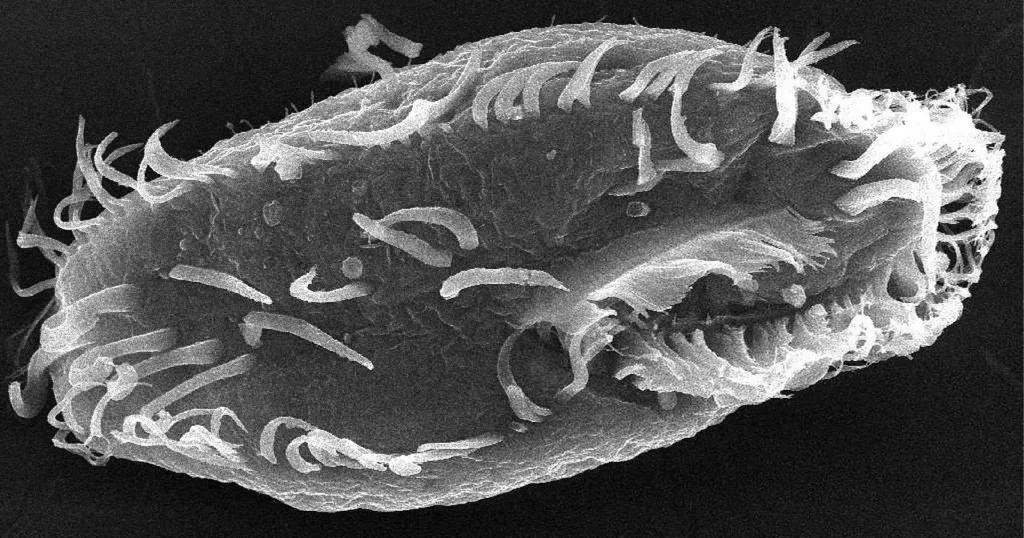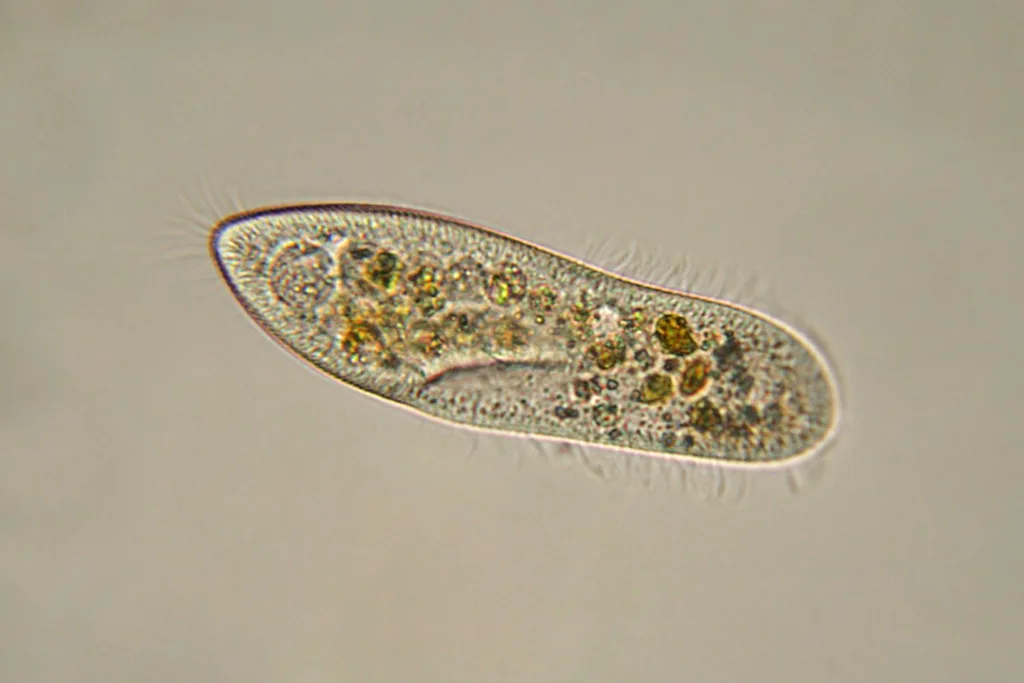Protozoa are fascinating single-celled organisms that belong to the division of protists. They are classified as eukaryotes, which means that they have a nucleus and other membrane-bound organelles. Protozoans are known for their incredible diversity and are found in almost every environment on Earth, from freshwater to soil to the human gut.
One of the most interesting characteristics of protozoa is their mobility. Many protozoans are capable of movement via various structures, such as cilia, flagella, and pseudopodia (false feet). This allows them to navigate through their environment and capture prey.
But do protozoa have cell walls? The answer is no. Unlike many other types of cells, protozoa do not have a cell wall. Instead, they have a thin, flexible, proteinaceous covering called a pellicle. This pellicle helps to maintain the shape of the cell and protect it from damage, but it is not as rigid or protective as a cell wall.
The absence of a cell wall allows protozoa to be more flexible and adaptable than other types of cells. They can change shape, move more easily, and interact with their environment in a variety of ways. However, it also makes them more vulnerable to certain types of stress, such as osmotic pressure changes.
In contrast, plant cells possess a rigid cell wall made of cellulose that provides structural support and protection. Fungal cells have a cell wall made of chitin, whie bacterial cells have a cell wall made of peptidoglycan. These cell walls are essential for the survival and function of these organisms.
Protozoa are a unique and fascinating group of organisms that lack a cell wall, but make up for it with their incredible mobility and adaptability. Their pellicle serves as a protective covering, but also allows them to interact with their environment in a more flexible manner. Understanding the biology and characteristics of protozoa can provide insights into the diversity of life on our planet.
Lack of Cell Walls in Protozoans
Protozoans are unicellular organisms belonging to the Kingdom Protista. They lack cell walls because they are classified as animals, and unlike plants, animals do not possess cell walls. The absence of a cell wall in protozoans allows them to be more flexible and adaptable to their environment. Instead of a cell wall, protozoans have a plasma membrane that serves as a barrier between the cell and its environment, regulating the movement of substances in and out of the cell. This plasma membrane also allows protozoans to interact with their environment and othr cells, which is essential for their survival. Additionally, the absence of a cell wall enables protozoans to move and change shape, which is an important characteristic for some species that need to hunt or avoid predators. Therefore, the lack of a cell wall in protozoans is an adaptation that allows them to be more versatile and better suited to their environment.

The Cell Wall of Protozoa
Protozoa, unlike many other organisms, do not have a cell wall. Instead, they possess a pellicle, which is a flexible and elastic proteinaceous covering that provides support and protection to the cell. The pellicle is made up of a complex network of protein fibers that are arranged in a specific pattern to give the cell its characteristic shape and rigidity. Unlike the rigid cell wall of bacteria and plants, the pellicle is flexible and allws the cell to change shape and move around. The absence of a cell wall also allows protozoa to engulf and digest food particles through the process of phagocytosis, which is not possible in cells with a rigid cell wall. Overall, the pellicle serves as an essential structure that provides mechanical support, protection, and flexibility to the protozoan cell.
Do Fungi and Protozoa Have Cell Walls?
Yes, fungi have cell walls, and their cell walls are mainly composed of a complex polysaccharide called chitin. The chitin gives the fungal cell wall its rigidity and strength. The cell walls of fungi also contain other polysaccharides, glycoproteins, and other compounds.
On the other hand, protozoa do not have cell walls. Instead, they have a flexible and thin plasma membrane that surrounds the cell. This membrane is composed of a lipid bilayer with embedded proteins that control the movement of molecules in and out of the cell. Protozoa rely on this membrane to maintain their shape and protect their internal structures.
In summary, while both fungi and protozoa have diffeent methods of protecting their cells, fungi have cell walls composed of chitin, while protozoa rely on a flexible plasma membrane.
Do Protozoa Have Cellulose Cell Walls?
No, protozoa do not have cellulose cell walls. In fact, protozoa, which are single-celled eukaryotes, lack cell walls altogether. Unlike plants, which have rigid cell walls made of cellulose, protozoa have a flexible cell membrane that allows them to move and change shape. This mobility is a key characteristic of protozoa and allows them to hunt for food, avoid predators, and adapt to changing environments. While some protozoa may secrete a protective outer layer, this is not the same as a cell wall and is not made of cellulose. Overall, protozoa are unique organisms that have evolved a range of strategies for survival without the need for a cell wall.
Absence of Cell Wall in Protozoa
Yes, the cell wall is absent in protozoa. Protozoa are unicellular eukaryotic microorganisms that belong to the kingdom Protista. Unlike bacteria and plants, protozoa lack a rigid cell wall surrounding the plasma membrane. Instead, they have a flexible and dynamic cell membrane that allows them to change their shape and move around. This membrane is composed of lipids and proteins and serves as a barrier between the cell and its environment. The absence of a cell wall in protozoa enables them to engulf food particles and move throgh narrow spaces. However, some protozoa have an external covering called a pellicle, which provides support and protection but is not a true cell wall.

Organisms Without Cell Walls
Animal cells do not have cell walls. This means that all animals, including humans, lack cell walls. The absence of a cell wall in animal cells allows them to be more flexible and dynamic in shape compared to plant cells, which have a rigid cell wall. However, it is worth noting that the cell wall is present in plant cells, bacteria, and fungi. The cell wall provides structural support and protection to these organisms, and it also helps maintain their shape.
Do Protozoa Have Cell Walls?
Yes, protozoa have a thick cell wall that serves as a protective barrier against external threats. The cell wall of protozoa is made up of complex molecules such as chitin, cellulose, or silica, which vary depending on the species. This thick cell wall not only provids physical support to the cell but also plays a crucial role in maintaining the osmotic balance of the cell. In addition to the cell wall, protozoa have a flexible outer membrane that allows them to change shape and move around. Overall, the thick cell wall of protozoa is an essential feature that enables these organisms to survive in a wide range of environments, both as free-living organisms and as parasites.
Do Protists Have Cell Walls?
No, not all protists have a cell wall. While some protists, such as diatoms and dinoflagellates, have a rigid cell wall made of silica or cellulose, others lack a cell wall altogether. For example, amoebas and ciliates have a flexible cell membrane that allows them to change shape and move without the need for a rigid structure. Some protists also have a combination of a cell wall and a cell membrane, depending on their specific neds for protection and movement. Therefore, it is important to note that the presence or absence of a cell wall varies among different types of protists.
Do Protozoa Have a Cell Membrane?
Yes, protozoa have a cell membrane. The cell membrane is a thin, flexible layer that encloses the entire cell and separates the internal environment from the external environment. It is composed of a phospholipid bilayer, which consists of two layers of lipids with hydrophobic tails facing each oher and hydrophilic heads facing outward. The cell membrane plays a crucial role in maintaining the integrity of the cell and regulating the passage of materials in and out of the cell. In addition to the cell membrane, protozoa also have other membrane-bound organelles, such as mitochondria and lysosomes, that perform specific functions within the cell.

Types of Organisms With Cell Walls
There are four main types of organisms that have a cell wall. Firstly, prokaryotes such as bacteria and cyanobacteria have a cell wall made up of peptidoglycan. Secondly, plant cells have a cell wall made up of cellulose, hemicellulose, and pectin. Thirdly, fungi have a cell wall made up of chitin and other polysaccharides. Fourthly, some protists such as diatoms and algae have a cell wall made up of silica or cellulose. It is important to note that while some organisms have a cell wall, it is absent in others, such as animal cells.
Structure of Protozoa
Protozoa are unicellular eukaryotic organisms that possess a well-defined cellular structure. Unlike prokaryotes, protozoa have a true nucleus that is enclosed by a nuclear membrane. The nucleus contains the genetic material of the cell, such as DNA or RNA, and is responsible for controlling all cellular activities.
In addition to the nucleus, protozoa also have oter organelles that are responsible for various functions. For example, they have mitochondria that generate energy for the cell through the process of cellular respiration. They also have a Golgi apparatus, which is involved in packaging and transporting cellular materials.
Another important organelle in protozoa is the contractile vacuole, which is responsible for regulating water content within the cell. In some species, protozoa may also have a flagellum or cilia that help in movement.
Overall, the cellular structure of protozoa is well-defined, with various organelles performing specific functions. This complexity allows protozoa to carry out various metabolic processes and survive in diverse environments.
Do All Microorganisms Possess Cell Walls?
No, not all microorganisms have cell walls. While many bacteria do have cell walls, there are other types of microorganisms, such as archaea and some types of fungi, that do not have cell walls. Additionally, some bacteria have lost their cell walls through evolution and have become intracellular parasites, relying on their host cells for structural support. It is important to note that the presence or absence of a cell wall can have significant implications for the survival, growth, and pathogenicity of microorganisms.
Kingdom That Lacks Cell Walls
The kingdom that lacks cell walls is the kingdom Protista. Protists are unicellular organisms that are known for ther ability to move through their environment by using cilia, flagella, or amoeboid mechanisms. While some protists may have a cell wall, it is not a defining characteristic of the group. In fact, many protists lack a cell wall altogether. This allows them to adopt diverse shapes and sizes, and to adapt to a wide range of environments. Without a cell wall, protists are also able to interact more closely with their surroundings, which can be beneficial for activities such as feeding and reproduction. Overall, the lack of a cell wall is an important feature of protists that sets them apart from other kingdoms in the living world.

Bacteria Without Cell Walls
The kingdom that does not have cell walls is the kingdom Monera. Monera is a prokaryotic kingdom that includes various types of unicellular microorganisms such as bacteria, actinomycetes, mycoplasma, cyanobacteria, and archaebacteria. Unlike other kingdoms, Monera organisms do not have distinct membrane-bound organelles, such as nuclei, and their genetic material is not enclosed within a nuclear membrane. Additionally, Monera organisms are knwn for their small size and simple structure. While many Monera organisms do have cell walls, some do not, such as the bacteria Mycoplasma. These organisms are unique in that they lack a cell wall altogether, making them the smallest and simplest cells known to exist.
Characteristics of Protozoa
Protozoa are a diverse group of single-celled organisms that exhibit a range of characteristics. These organisms are either free-living or parasitic, and they can be found in various habitats, including soil, water, and inside other organisms. Protozoa lack a cell wall, which distinguishes them from other unicellular organisms such as bacteria and fungi.
Protozoa are generally heterotrophic, meaning that they obtain thir nutrients from organic matter in their environment. Some protozoa are able to ingest particles of food, while others absorb nutrients directly through their cell membrane.
Protozoa are capable of reproducing asexually through processes such as binary fission, schizogony, or budding. These processes involve the splitting of the protozoan’s cell into two or more daughter cells, which then grow into mature individuals.
In terms of classification, there are more than 6500 known species of protozoa. They are typically classified based on their morphology, behavior, and mode of nutrition. Some common types of protozoa include amoebas, ciliates, flagellates, and sporozoans.
Overall, protozoa display a wide range of characteristics that reflect their diverse lifestyles and adaptations to various environments. Their ability to exist as single-celled organisms and reproduce asexually makes them a fascinating group of organisms to study.
Conclusion
In conclusion, protozoa are unicellular eukaryotic organisms that are commonly found in diverse habitats such as soil, water bodies, and even in the digestive tracts of animals. Despite their small size, protozoa exhibit a remarkable range of morphological diversity and metabolic capabilities. They play an important role in various ecosystems, serving as primary producers, decomposers, and as a food source for larger organisms. Protozoa are also important in medical and veterinary science, as some species are responsible for causing diseases such as malaria, amoebic dysentery, and sleeping sickness. Due to their unique characteristics and ecological significance, protozoa continue to be a subject of interest for researchers in various fields of biology.
